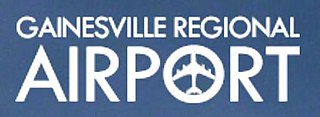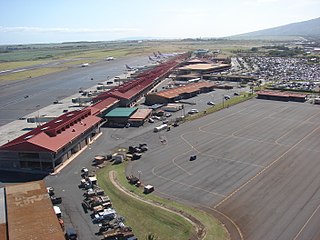Related Research Articles

Stewart International Airport, officially New York Stewart International Airport, is a public/military airport in Orange County, New York, United States. It is in the southern Hudson Valley, west of Newburgh, south of Kingston, and southwest of Poughkeepsie, approximately 60 miles (97 km) north of Manhattan, New York City. The airport is located within the towns of Newburgh and New Windsor. It is included in the Federal Aviation Administration (FAA) National Plan of Integrated Airport Systems for 2017–2021, in which it is categorized as a non-hub primary commercial service facility.

Austin–Bergstrom International Airport, or ABIA, is a Class C international airport in Austin, Texas, United States, serving the Greater Austin metropolitan area. Located about 5 miles (8 km) southeast of downtown Austin, it covers 4,242 acres (1,717 ha) and has two runways and three helipads.

Gainesville Regional Airport is a public airport three miles northeast of Gainesville, in Alachua County, Florida, United States. It is owned by Gainesville-Alachua Co. Auth. The National Plan of Integrated Airport Systems for 2011–2015 categorized it as a primary commercial service airport.

Birmingham–Shuttlesworth International Airport, formerly Birmingham Municipal Airport and later Birmingham International Airport, is a civil-military airport serving Birmingham, Alabama. The airport also provides scheduled airline service for the Birmingham and Tuscaloosa metropolitan areas. It is located in Jefferson County, five miles northeast of Downtown Birmingham, near the interchange of Interstates 20 and 59.

Kahului Airport is the main airport of Maui in the State of Hawaii, United States, located east of Kahului. It has offered full airport operations since 1952. Most flights into Kahului Airport originate from Daniel K. Inouye International Airport in Honolulu; the Honolulu–Kahului corridor is one of the heaviest-trafficked air routes in the US, ranking 13th in 2004 with 1,632,000 passengers.

Tweed-New Haven Regional Airport is a public airport located three miles southeast of downtown New Haven, in New Haven County, Connecticut, United States. The airport is partly located in the City of New Haven, which owns the airport, and partly in the town of East Haven.
Dillingham Airfield is a public and military use airport located two nautical miles (4 km) west of the central business district of Mokulēʻia, in Honolulu County on the North Shore of Oʻahu in the U.S. state of Hawaii. It is operated by the Hawaii Department of Transportation under a 25-year lease from the United States Army. The airport is primarily used for gliding and sky diving operations, and also houses Civil Air Patrol (CAP) glider aircraft. Military operations consist largely of night operations for night vision device training and orientation flights for the United States Air Force Auxiliary (CAP). This airport is included in the Federal Aviation Administration (FAA) National Plan of Integrated Airport Systems for 2017–2021, in which it is categorized as a basic general aviation facility.

Mobile International Airport is a public use airport located three nautical miles (6 km) south of the central business district of Mobile, a city in Mobile County, Alabama, United States. The airport is a principal component of the Mobile Aeroplex at Brookley, a 1,650-acre (668 ha) industrial complex. It is owned and operated by the Mobile Airport Authority. Prior to 1969, the airport was part of an active military installation known as Brookley Air Force Base.

Montgomery Regional Airport is a civil-military airport seven miles southwest of Montgomery, the capital of Alabama. Owned by the Montgomery Airport Authority, it is used for general aviation and military aviation, and sees two airlines.

Coleman A. Young International Airport is six miles northeast of downtown Detroit, in Wayne County, Michigan. It is owned by the City of Detroit. The Federal Aviation Administration (FAA) National Plan of Integrated Airport Systems for 2017–2021 categorized it as a regional general aviation facility. In 2003, it was given its current name in honor of the late former mayor of Detroit.

Roanoke–Blacksburg Regional Airport is three miles northwest of Roanoke, Virginia. It is governed by the five-member Roanoke Regional Airport Commission, which includes representatives from both the city and county of Roanoke. The airport has two runways and an average of 116 operations a day; it covers 912 acres.

Chicago Rockford International Airport, typically referred to as Rockford International Airport, Chicago Rockford, or by its IATA call letters, RFD, is a commercial airport in Rockford, Illinois, located 68 miles northwest of Chicago. Established in 1946, the airport was built on the grounds of the former Camp Grant facility, which served as one of the largest training facilities for the U.S. Army during both World Wars. The Federal Aviation Administration (FAA) National Plan of Integrated Airport Systems for 2017–2021 categorized it as a non-hub primary commercial service facility.

MidAmerica St. Louis Airport is a public use airport next to Scott Air Force Base. It is 14 nautical miles east of the central business district of Belleville and 18 nautical miles east of downtown St. Louis in St. Clair County, Illinois, United States.

Auburn University Regional Airport with the Robert G. Pitts Field is a public use airport located two nautical miles (4 km) east of the central business district of Auburn, a city in Lee County, Alabama, United States. The airport is owned by Auburn University and was formerly known as Auburn–Opelika Robert G. Pitts Airport. It is included in the National Plan of Integrated Airport Systems for 2011–2015, which categorized it as a general aviation facility.

Hartford–Brainard Airport is a towered public airport three miles (5 km) southeast of downtown Hartford, in Hartford County, Connecticut. It is owned by the Connecticut Airport Authority. The Federal Aviation Administration (FAA) National Plan of Integrated Airport Systems for 2017–2021 categorized it as a regional reliever airport facility.

St. Clair County Airport is a public use airport located three nautical miles southeast of the central business district of Pell City, in St. Clair County, Alabama, United States. It is owned by the St. Clair County Airport Authority. According to the FAA's National Plan of Integrated Airport Systems for 2009–2013, it is categorized as a reliever airport for the Birmingham-Shuttlesworth International Airport.
The proposed Chicago south suburban airport is a proposed airport that would be located in Peotone, Illinois, United States, approximately 40 miles (64 km) south of Chicago. Serving in addition to the two international commercial airports serving Chicago, the site would serve the south suburbs of the Chicago metropolitan area. The two existing airports currently serving Chicago are located within and operated by the City of Chicago, with the Northern Illinois region also served by two other international airports in Illinois and Wisconsin.

Interstate 422 (I-422), Corridor X-1, or the Birmingham Northern Beltline is a proposed 52.5-mile-long (84.5 km) northern bypass route around Birmingham, Alabama, through northern and western Jefferson County that is projected to be completed by 2047. Along with the existing I-459, the Northern Beltline would complete the bypass loop of central Birmingham for all Interstate traffic. The project's budget is $5.445 billion; upon completion, the Northern Beltline will be the most expensive road in Alabama's history, and among the most expensive per mile ever built in the United States.

Chilton County Airport, also known as Gragg-Wade Field, is a public-use airport in Chilton County, Alabama, United States. It is located one nautical mile (2 km) east of the central business district of Clanton, Alabama. It is owned by the Chilton County Airport Authority.

Courtland Airport is a public-use airport located two nautical miles northeast of the central business district of Courtland, a town in Lawrence County, Alabama, United States. It is owned by the Lawrence County Commission and was formerly known as Lawrence County Airport.
References
- Alabama International Airport Authority at BhamWiki.com - accessed January 3, 2007
- Williams, Roy (June 25, 1993) "Bell heads airport seekers." Birmingham News.
- Williams, Roy (July 15, 1993) "Bell says city airport "No. 1" site to locate international airport." Birmingham News.
- Kennedy, James H. (September 30, 1993) "Chilton site early choice for airport." Birmingham News.
- Lindly, Tom (July 28, 1994) "State picks St. Clair for proposed airport." Birmingham News.
- AP Reports (July 28, 1994) "St. Clair site picked for airport." Mobile Register.
- AP Reports (August 18, 1995) "Authority OK's plan for new airport." Birmingham News.